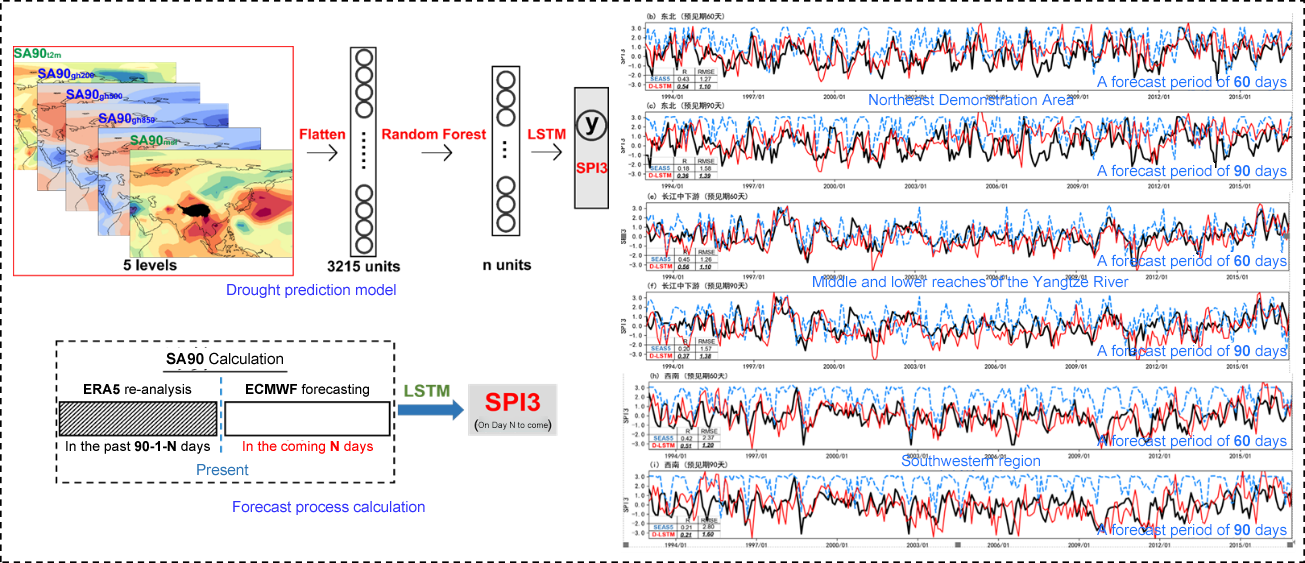I. Research Background
Drought is a persistent problem in China due to its unique geographic and climatic conditions. As the socio-economic development accelerates and the global climate change increases, large-scale drought disasters remain a major challenge impeding the high-quality development of China. Against this backdrop, China Institute of Water Resources and Hydropower Research (IWHR) took the lead in undertaking the “Large-scale Drought Monitoring, Forecasting and Disaster Risk Preparedness Technologies and Demonstration”, a key project funded by the National Key R&D Program “Major Natural Disaster Monitoring, Early Warning and Prevention”. The project has passed the comprehensive performance evaluation in July 2022.
II. Research Results
1. Revealing the mechanisms and evolution patterns of large-scale, long-lasting droughts in a changing environment
Based on an analysis of hydrological imbalance throughout the whole water cycle, the project examined the dynamic coupling mechanism of water and energy exchanges among the atmosphere, land surface, soil and subsurface amidst intensive human activities and a changing climate, and scientifically described the mechanisms of meteorological, hydrological and agricultural droughts. By restructuring the regional drought sequences on multiple time scales since the Holocene and the historical sequence of droughts in the past 500 years, the project explored future evolving patterns of meteorological, hydrological and agricultural droughts, while considering the impact of the changing environment over the past four decades.

Figure 1 Evolution patterns of large-scale, long-lasting droughts in a changing environment
2. Proposing a technology for high-precision monitoring and comprehensive evaluation of droughts in recognition of environmental characteristics of the underlying surface
By studying the relation of distribution function with similar probability based on the data from more than 40,000 high-density meteorological and hydrological stations and long-sequence national meteorological and hydrological stations, the project set up standardized high-density climate fields; developed a technique for integrating high-intensity ground monitoring, multi-source remote sensing observation and land surface assimilation system datasets, while different underlying surface conditions such as land use, soil, crops and irrigation were considered, thus achieving high-precision monitoring and comprehensive evaluation of droughts.

Figure
2 High-precision meteorological drought monitoring technology based on
standardized climate fields
3. Developing the multi-scale drought forecasting and prediction technology based on multiple climate models and multi-model coupling
The project was built on the multi-model integrated prediction technology with reference to the Bayes theorem, and incorporated the impact of global large-scale climate factors and regional small- and medium-scale physical processes on precipitation, successfully improving the accuracy of precipitation forecasting. By coupling the hydrological-crop models and considering the impact of irrigation processes and dynamic changes of vegetation, the project developed a multi-scale, parameter-adaptive coupled atmospheric-hydrological drought forecasting model, depicted in detail the process of drought evolution under the interactions among atmosphere, hydrology and human activities, enabling the monthly-scale rolling forecasting of droughts on a daily basis. By establishing the correlation between regional droughts and climate system anomalies, the project built a seasonal-scale drought probability forecasting model to support seasonal-scale forecasting of large-scale droughts.

Figure 3 Technology for comprehensive evaluation of regional droughts in recognition of multi-source data and underlying surface conditions

Figure 4 Monthly-scale drought rolling forecasting technology based on coupled atmospheric-hydrological models

Figure 5 Seasonal-scale drought prediction model based on machine learning
4. Proposing a technology for dynamic evaluation and comprehensive prevention decision-making of drought risks based on drought process
Based on a study of the response mechanisms of those affected by droughts, the project built a dynamic simulation and evaluation model for agricultural, urban and ecological drought risks relied on drought process response mechanisms, in an effort to attain a dynamic prediction of drought risks. The project proposed technologies for analyzing water demand of during arid period and for coordinated allocation of emergency water supply during large-scale, long-lasting droughts, thus building a multi-agent, multi-target and multi-process decision support model for drought risk prevention, as well as constructing a risk control and prevention system applicable to large-scale and long-lasting droughts.

Figure 6 Dynamic evaluation model for agricultural drought risks based on crop growth and drought forecasting

Figure 7 Coordinated allocation model for emergency water supply during large-scale and long-lasting droughts
III. Promotion and Application
Drawing upon the key technologies developed mainly on drought monitoring and evaluation, drought forecasting and prediction, and dynamic evaluation and control of drought risks, the project further developed a cloud-powered drought monitoring, forecasting and disaster risk prevention platform which fully integrates the collective technologies and services covering the whole drought management process. The platform has been demonstrated and applied in Northeast China, middle and lower Yangtze and Southwest China. It has served as an important pilot program in supporting the smart water management strategy proposed by the Ministry of Water Resources of China, in particular contributing to the efforts in develop a “Forecasting, Early Warning, Preparedness and Early Action” mechanism for drought prevention.